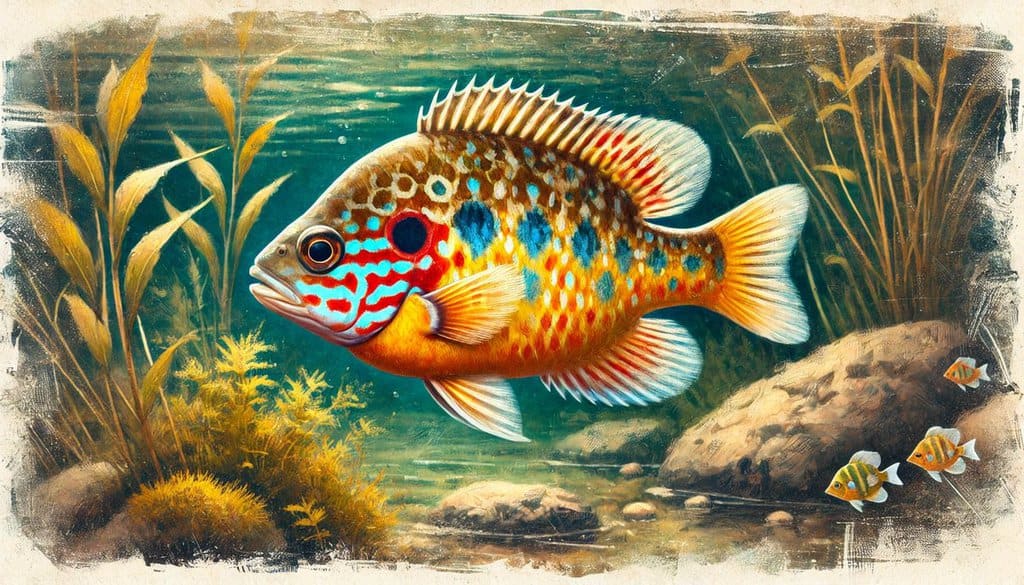The pumpkinseed sunfish is a vibrant and hardy species popular in aquaponics systems due to its adaptability and resilience. Known for its striking coloration and manageable size, this species thrives in diverse environmental conditions, making it an attractive choice for both ornamental and practical purposes in aquaponics.
Natural Habitat and Behavior
Origin and Native Environment: Pumpkinseeds are native to North American freshwater systems, including rivers, lakes, and ponds. They have been introduced to various regions worldwide, adapting well to different habitats[4].
Natural Behavior in the Wild: In their natural environment, pumpkinseeds exhibit a range of behaviors including nesting and parental care. They are known for building nests in shallow waters during the breeding season[5]. Their diet primarily consists of insects, crustaceans, and small fish.
Temperament and Compatibility: Pumpkinseeds can be somewhat territorial, especially during breeding seasons. In aquaponics systems, they are generally docile but may exhibit aggression if space is limited. They can coexist with other non-aggressive species that require similar environmental conditions.
Water Requirements
Temperature Range: Pumpkinseeds prefer water temperatures between 18°C to 24°C (64°F to 75°F). Extreme temperatures outside this range can stress the fish and affect their growth and health.
pH Level: The optimal pH range for pumpkinseeds is between 6.5 and 8.0. They are relatively tolerant of minor pH fluctuations but thrive best within this range.
Water Hardness and Oxygen Levels: Pumpkinseeds prefer moderately hard water. They require well-oxygenated environments but can tolerate lower oxygen levels temporarily. Regular aeration is recommended to maintain optimal health.
Ammonia/Nitrate Sensitivity: Like many fish species, pumpkinseeds are sensitive to high levels of ammonia and nitrates. Maintaining clean water through regular filtration and monitoring is crucial to prevent toxic build-up.
Tank or Pond Setup
Tank/Pond Size Requirements: A minimum tank size of 100 liters (26 gallons) is recommended for a small group of pumpkinseeds to ensure adequate space for swimming and territorial behavior.
Filtration & Aeration: Effective filtration is essential to maintain water quality. Pumpkinseeds benefit from moderate water flow and aeration to mimic their natural habitat conditions.
Lighting Considerations and Tank Decorations/Substrate: Pumpkinseeds do not have specific lighting requirements but benefit from a natural day-night cycle. Substrates like sand or gravel with plenty of hideaways using rocks or plants can provide comfort and reduce stress.
Feeding Requirements
Diet: Pumpkinseeds are omnivorous, enjoying a varied diet that includes pellets, insects, crustaceans, and plant matter. Providing a balanced diet ensures optimal growth and health.
Feeding Techniques: Feeding should occur once or twice daily, ensuring that food particles are small enough for easy consumption. Observing natural feeding habits like scavenging helps maintain a clean tank environment.
Growth and Reproduction
Growth Rate and Physical Growth Indicators: Pumpkinseeds grow relatively quickly under optimal conditions, reaching maturity within one year. They typically attain a size of about 15 cm (6 inches).
Breeding Behavior: Breeding is influenced by temperature increases in spring. Males build nests where females lay eggs. Breeding within aquaponics systems requires stable conditions with slight temperature increases to stimulate spawning[5].
Harvesting & Culinary Considerations
While pumpkinseeds are more commonly kept for ornamental purposes in aquaponics systems, they can be consumed. Their mild flavor makes them suitable for various cooking methods such as frying or baking.
Pros and Cons
- Hardy and adaptable to various conditions.
- Attractive appearance adds aesthetic value.
- Can coexist with other species under proper management.
- Potential aggression during breeding.
- Sensitive to poor water quality.
- Requires regular maintenance of water parameters.
Common Health Issues
Pumpkinseeds may suffer from common freshwater diseases such as ich or fin rot if water quality is poor. Regular monitoring of water parameters and maintaining cleanliness can prevent these issues.
Maintenance Tips for Long-Term Health
Routine maintenance includes weekly water tests and regular checks on filtration systems. Monitoring temperature, pH, ammonia, nitrate levels, and oxygen content is crucial for long-term health.
Closing Thoughts
The pumpkinseed sunfish offer a unique blend of beauty and resilience for aquaponics enthusiasts. Their adaptability makes them suitable for beginners looking to add an ornamental yet functional species to their system. Engaging with fellow aquaponics practitioners can provide valuable insights into optimizing care for these vibrant fish.
Other fish species for aquaponics
External sources:
[1] https://www.ncbi.nlm.nih.gov/pmc/articles/PMC5869894/
[2] https://www.semanticscholar.org/paper/d1ea58bc614d58642d2f288119b9ffd2039ac2ab
[3] https://www.semanticscholar.org/paper/52122f543c8ab54c5a6caef4598c1d96177012d0
[4] https://www.semanticscholar.org/paper/fb80491131d23e6ed7c175e434f4ad1c60b79c25
[5] https://www.semanticscholar.org/paper/c4788d9cf8c909dbf849a86d91e72a47a374ad33

